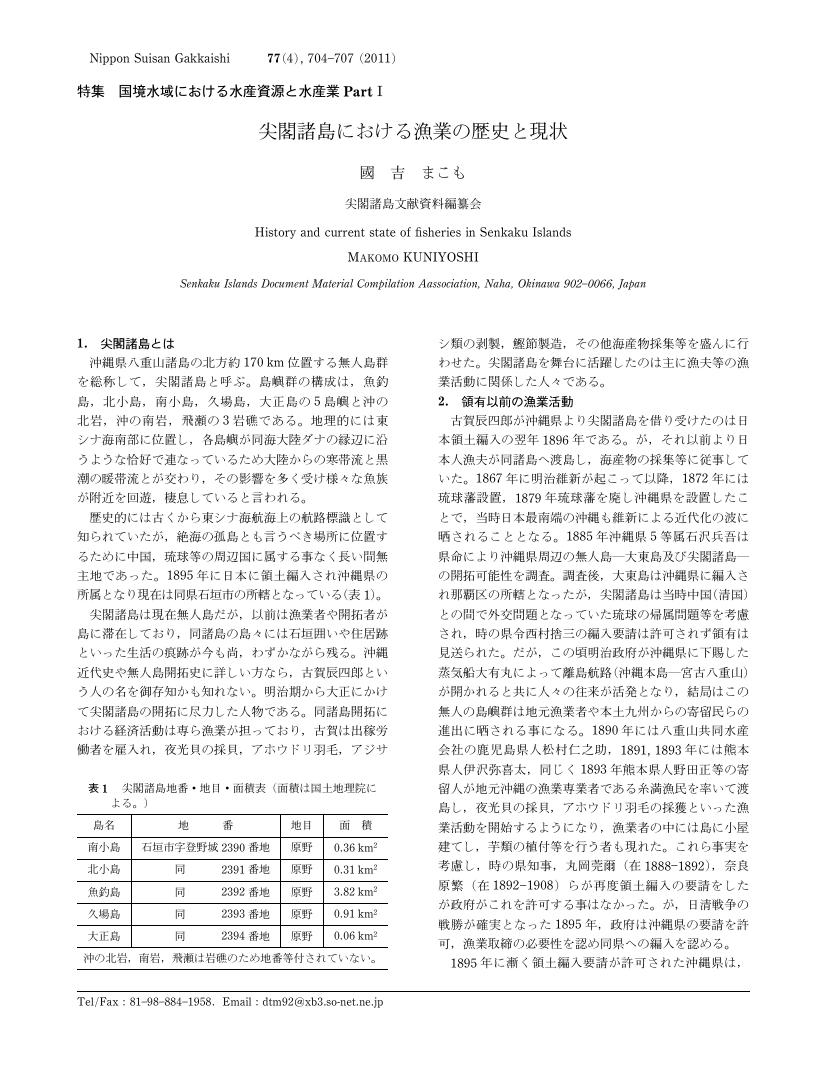53 0 0 0 OA 日本産ひるむしろ属
- 著者
- 牧野 富太郎
- 出版者
- 公益社団法人 日本植物学会
- 雑誌
- 植物学雑誌 (ISSN:0006808X)
- 巻号頁・発行日
- vol.1, no.1, pp.2-8, 1887 (Released:2007-04-05)
53 0 0 0 OA 自殺対策基本法制定後の政策過程
- 著者
- 小牧 奈津子
- 出版者
- 日本NPO学会
- 雑誌
- ノンプロフィット・レビュー (ISSN:13464116)
- 巻号頁・発行日
- vol.17, no.1, pp.11-22, 2017 (Released:2017-07-05)
- 参考文献数
- 40
本稿では,自殺対策基本法制定以降の政策過程を検討し,そこでNPOが与えた影響を明らかにするとともに,その影響力の源泉の導出を試みた.NPO法人ライフリンク代表の清水康之へのインタビューと,2つの諮問機関での議論の分析から,ライフリンクは,遺族とのつながりを通じて自殺の実態に関する貴重な情報を取得するだけでなく,国会議員とのつながりを構築・強化してきたことが明らかとなった.この国会議員との関係性が,ライフリンクの政策提言の影響力を高める源泉として機能したといえる.ただしNPOが政策過程でそうした大きな影響を及ぼすことには,弊害や危険性を指摘する声も少なくない.実際,本稿からも諮問機関での議論をバイパスし,NPOが政策過程に直接,強い影響を与えている様子が浮き彫りになった.この影響を検証・評価するためには,その後の政策過程を含めて更なる検討を行っていくことが必要であろう.
53 0 0 0 OA 小学校における運動部活動の分布 : 市区町村別実施状況マップの作成
- 著者
- 青柳 健隆 鈴木 郁弥 荒井 弘和 岡 浩一朗
- 出版者
- 日本スポーツ産業学会
- 雑誌
- スポーツ産業学研究 (ISSN:13430688)
- 巻号頁・発行日
- vol.28, no.3, pp.265-273, 2018 (Released:2018-08-02)
- 参考文献数
- 17
- 被引用文献数
- 1
School-based extracurricular sports activity (SBECSA) has widely spread in Japan as a means for youth to play sports or exercise. Especially in junior high school and high school, SBECSA is actively conducted with a high participation rate of students. There have also been reports that elementary schools in some Japanese municipalities also have SBECSA. However, there has been little information about which municipalities conducted SBECSA in elementary schools. Therefore, the present study aimed to clarify the existence of SBECSA in elementary schools in each municipality, and to create a municipal map of implementation status. A complete enumeration questionnaire survey was conducted with all 1741 municipalities’ educational boards. Question items were in regard to the existence of elementary schools’ SBECSA in their municipalities. Answerers were requested to choose one response from the items; “almost all elementary schools have SBECSA”, “some elementary schools have SBECSA”, “there were SBECSA (about 10 years ago), but now there is no SBECSA”, “there weren’ t any SBECSA before 10 years ago”, “we don’ t know”, and “we don’ t answer” . To increase the response rate, a second survey was conducted with Sports Associations or similar sports related organizations in each municipality. Additionally, a third survey was conducted with educational boards again at the same time as the feedback of results was given. As results, 88.0% of all municipalities’ implementation status was identified (response rate = 92.5%). And 23.0% of all municipalities were shown to have SBECSA in elementary schools, although 64.9% did not have it. More than half of the municipalities in Aomori prefecture, Chiba prefecture, Aichi prefecture, and Kumamoto prefecture have SBECSA in elementary school. Based on the results of the present study, it is suggested that further development of the youth sport environment should be discussed. In addition, means to decrease the burdens on teachers who coach and manage SBECSA must be considered.
- 著者
- Nobuyuki Nakama Yasuyuki Nakamura Haruki Tatsuta Zoltán Korsós
- 出版者
- Arachnological Society of Japan
- 雑誌
- Acta Arachnologica (ISSN:00015202)
- 巻号頁・発行日
- vol.71, no.1, pp.5-12, 2022-06-30 (Released:2022-07-02)
A new pill millipede species, Hyleoglomeris magy sp. nov., is described from Okinawa and adjacent islands, Ryukyu Archipelago, Japan. The new species is mainly characterized by its large body (maximum length: 12.1mm) and general light yellowish-brown coloration marked with pairs of blackish spots. The general appearance of the new species resembles that of Hyleoglomeris hongkhraiensis Golovatch & Panha 2015, but can be distinguished from this species by the number of striae on the thoracic shield (typically 8–10, with 3 or 4 crossing the dorsum, vs 7 or 8 in total with 4 or 5 crossing the dorsum) and the shape of the telopod (femur strongly bulged distally, vs not bulged). An identification key to all five species of Hyleoglomeris known to occur in the Ryukyu Archipelago is also provided.
- 著者
- 野口 聡一 木下 冨雄
- 出版者
- 日本社会心理学会
- 雑誌
- 社会心理学研究 (ISSN:09161503)
- 巻号頁・発行日
- vol.30, no.1, pp.1-10, 2014-08-18 (Released:2015-03-30)
- 参考文献数
- 18
The purpose of this study is to investigate how a microgravity environment affects spatial orientation, the cognitive system, and interpersonal relationships, hence changes in gravity reference frames. After leaving the terrestrial globe, astronauts experience drastic perceptual disturbances (temporary loss of the senses of spatial- and self-orientation). However, they gradually learn to adapt to the novel environment by developing new perceptual and behavioral skills. First, we examined video clips of an astronaut’s body movement inside the International Space Station (ISS) by using a motion video analysis technique. We discovered that a microgravity environment definitely affects spatial orientation. Second, we analyzed how social hierarchy organization, metaphorical expression, and psychological stabilization were affected by space adaptation.
53 0 0 0 OA Twitterからの言及数が多い論文は言及されたことのない論文と比べてタイトルが「面白い」
- 著者
- 佐藤 翔 石橋 柚香 南谷 涼香 奥田 麻友 保志 育世 吉田 光男
- 出版者
- 情報知識学会
- 雑誌
- 情報知識学会誌 (ISSN:09171436)
- 巻号頁・発行日
- pp.2019_035, (Released:2019-07-19)
- 参考文献数
- 25
本研究では非専門家にとっての論文タイトルの「面白さ」を得点化し,Twitterからの言及数が多い論文と言及されたことのない論文でこの得点に差があるかを検証した.Twitterからの言及数データはCeek.jp Altmetricsから収集し,2008年に出版された論文の中でTwitterからの言及回数が特に多い論文103本と,言及回数が0の論文の中からランダムに選択した100本を分析対象とした.4名の非専門家が各論文タイトルの「面白さ」を7段階で評価し,その点数の合計を「面白さ」得点と定義した.分析の結果,Twitterからの言及数が多い論文グループと,言及数が0の論文グループで「面白さ」得点には有意な差が存在し,Twitterからの言及数が多い論文の方がタイトルが「面白い」傾向が確認された.さらに,この差は分野別に分析しても確認された.
53 0 0 0 OA 朝鮮総督府水産試験場報告
- 著者
- 朝鮮総督府水産試験場 編
- 出版者
- 朝鮮総督府水産試験場
- 巻号頁・発行日
- vol.第6号, 1939
53 0 0 0 OA 理科教育学における再現性の危機とその原因
- 著者
- 中村 大輝 原田 勇希 久坂 哲也 雲財 寛 松浦 拓也
- 出版者
- 一般社団法人 日本理科教育学会
- 雑誌
- 理科教育学研究 (ISSN:13452614)
- 巻号頁・発行日
- vol.62, no.1, pp.3-22, 2021-07-30 (Released:2021-07-30)
- 参考文献数
- 90
近年,教育学を含む多くの学問分野において過去の研究知見が再現されないという再現性の危機が問題となっており,その原因の1つとして問題のある研究実践(Questionable research practices, QRPs)の存在が指摘されている。本研究では,国内の理科教育学分野におけるQRPsの実態を明らかにし,再現性問題への具体的な対応策を提案することを目的として,『理科教育学研究』に掲載された過去4年間の論文におけるQRPsの状況を分析した。その結果,8種類のQRPs(妥当性の確認不足,母集団の未定義,出版バイアス,誤った多重比較,検定力不足,HARKing,過度の一般化,記載情報の不足)が行われていることが示唆され,理科教育学分野の実証研究における研究方法の問題点が明らかになった。また,再現性問題の解決に向けて,QRPsを防止するために,本誌に関わる研究者,実践者,編集委員会が取り組むべき対応策として「追試の積極的な実施」「適切な研究方法の普及」「事前登録制度の導入」「オープンサイエンスの実施」の点から4つのアイデアを示した。
53 0 0 0 OA 北大立法過程研究会資料 議員立法における治安関係立法について -静穏保持法を中心として-
- 著者
- 上田 章
- 出版者
- 北海道大学法学部
- 雑誌
- 北大法学論集 (ISSN:03855953)
- 巻号頁・発行日
- vol.41, no.1, pp.247-258, 1990-11-30
53 0 0 0 慢性疲労症候群におけるカルニチン動態と疲労症状との関連について
慢性疲労症候群(CFS)は、その特異な病態から近年強い注目を集め、社会的にも関心の深い疾患である。本疾患の病因については様々な説が提唱されているが未だ明らかでない。我々は細胞のエネルギー供給の代謝系において極めて重要な役割をはたしているカルニチンを測定したところ、血中の遊離カルニチンは正常ながら、アシルカルニチン値が大部分の症例で有意に低下していることを見い出した。尿中排泄増加はなく、ミトコンドリアにおける脂肪酸酸化を中心とした代謝系の何らかの異常が想定され、疲労を中心としたCFSの症状との関連が示唆された。また、カルニチン正常,アシルカルニチン低下という病態は現在までに数例の先天性異常例以外には知られておらず、検査法としての診断的意義も大きい。ともあれCFSでは生体代謝に関して生化学的に異常が見られたのは本物質が初めてである。これまでCFSで臨床検査異常や生化学的代謝物質の異常が見られないことより心因的機能的病態とする見解も少なくなかったが、我々の成績は器質的病変であることを強く示唆し、世界に大きなインパクトを与えた。本研究は、CFSにおけるアシルカルニチン減少のメカニズムを明らかにすることをめざすとともに、細胞レベルでのアシルカルニチンの作用やその代謝について下記の点について検討したものである。1)サイトカインとアシルカルニチンとの関連についてア)インターフェロンとの関連イ)TNFとの関連2)内在性アシルカルニチンの生理的意義についてア)絶食による変化イ)絶食後再節食による変化ウ)糖負荷による変化エ)糖負荷にともなうアシルカルニチンの動的変化の解析3)細胞内アシルカルニチンの測定4)治療の試み
53 0 0 0 OA 「風評被害」の社会心理 ―「風評被害」の実態とそのメカニズム―
- 著者
- 関谷 直也
- 出版者
- 日本災害情報学会
- 雑誌
- 災害情報 (ISSN:13483609)
- 巻号頁・発行日
- vol.1, pp.78-89, 2003 (Released:2021-04-01)
- 参考文献数
- 20
- 被引用文献数
- 2
本論では、「風評被害」の実態とその発生メカニズムを論じることに目的がある。実態を反映させ、定義づけると「風評被害とは、ある事件・事故・環境汚染・災害が大々的に報道されることによって、本来『安全』とされる食品・商品・土地を人々が危険視し、消費や観光をやめることによって引き起こされる経済的被害」のことである。元々は原子力に限定され用いられていた。概括して、「風評被害」は次のような過程を経る。[1]「人々は安全か危険かの判断つかない」「人々が不安に思い商品を買わないだろう」と市場関係者・流通業者が想定した時点で、取引拒否・価格下落という経済的被害が成立する。[2]「経済的被害」「人々は安全か危険かの判断つかない」「人々の悪評」を政治家・事業関係者、科学者・評論家、市場関係者が考える時点で「風評被害」が成立する。この時点でいわば「『人々の心理・消費行動』を想像することによる被害」である。[3]①経済的被害、②事業関係者・科学者・評論家・市場関係者の認識、③街頭インタビューの「人々の悪評」などが報道され、社会的に認知された「風評被害」となる。[4]報道量の増大に伴い、多くの人々が「危険視」による「忌避」する消費行動をとる。事業関係者・市場関係者・流通業者の「想像上の『人々の心理・消費行動』」が実態に近づき、「風評被害」が実体化する。
53 0 0 0 OA 尖閣諸島における漁業の歴史と現状
- 著者
- 國吉 まこも
- 出版者
- 公益社団法人 日本水産学会
- 雑誌
- 日本水産学会誌 (ISSN:00215392)
- 巻号頁・発行日
- vol.77, no.4, pp.704-707, 2011 (Released:2011-09-08)
- 参考文献数
- 3
53 0 0 0 OA 「英語の授業は基本的に英語で行う」方針について
- 著者
- 鳥飼 玖美子
- 出版者
- 公益財団法人 日本学術協力財団
- 雑誌
- 学術の動向 (ISSN:13423363)
- 巻号頁・発行日
- vol.22, no.11, pp.11_78-11_82, 2017-11-01 (Released:2018-03-28)
- 参考文献数
- 7
53 0 0 0 OA シングルセル解析の動向と展望
- 著者
- 仲嶋 なつ
- 出版者
- 特定非営利活動法人 日本バイオインフォマティクス学会
- 雑誌
- JSBi Bioinformatics Review (ISSN:24357022)
- 巻号頁・発行日
- vol.3, no.2, pp.61-74, 2022 (Released:2022-11-01)
- 参考文献数
- 115
生体組織のゲノム情報を個々の細胞レベルで網羅的に計測し解析するシングルセル解析が可能となり、組織を構成する各細胞の挙動や多様な細胞種の性質について分析することができる。シングルセル解析においては、各細胞での遺伝子発現量(Single-cell RNA sequencing)と数理的手法とに基づいて、細胞種分類や軌道推定、遺伝子間相互作用推定などが行われている。本稿では、scRNA-seqデータに関する基礎知識や、シングルセル解析の動向と注目のトピックスに関して、各解析の概要と適用される数理的手法について概説する。
53 0 0 0 OA 日本の公共空間における「男性」という性別の意味
- 著者
- 村田 陽平
- 出版者
- The Association of Japanese Geographers
- 雑誌
- 地理学評論 (ISSN:13479555)
- 巻号頁・発行日
- vol.75, no.13, pp.813-830, 2002-11-01 (Released:2008-12-25)
- 参考文献数
- 45
- 被引用文献数
- 3 3
本稿の目的は,従来の地理学ではほとんど検討されてこなかったセクシュアリティの視点に注目して,公共空間における男性という性別の意味を解明することである.日本のセクシュアルマイノリティの言説資料を基に,「外見の性」という性別に関わる概念を分析軸として検討する.まず「外見の性」が現代の公共空間といかに関連しているのかを考察する.次に,男性の「外見の性」に意味付けられる女性への抑圧性を検討し,その意味付けを行っている主体は,女性のみならず男性でもあることを示す.そして,公共空間における男性という性別は,「外見の性」が男性である状態を意味することを明らかにする.この知見は,日本における「女性専用空間」の意味を考える上で有意なものである.
- 著者
- T. Makino
- 出版者
- The Botanical Society of Japan
- 雑誌
- 植物学雑誌 (ISSN:0006808X)
- 巻号頁・発行日
- vol.25, no.299, pp.en251-en258, 1911 (Released:2007-05-24)
- 被引用文献数
- 1 2
53 0 0 0 OA 行動免疫システムと福島県近隣の汚染地域の推定との関連
- 著者
- 樋口 収 下田 俊介 小林 麻衣 原島 雅之
- 出版者
- 日本グループ・ダイナミックス学会
- 雑誌
- 実験社会心理学研究 (ISSN:03877973)
- 巻号頁・発行日
- vol.56, no.1, pp.14-22, 2016 (Released:2016-10-06)
- 参考文献数
- 28
- 被引用文献数
- 5 1
東京電力福島第一原子力発電所の事故から5年以上たった今なお福島県の産物の風評被害は続いている。なぜ消費者は福島県の産物を危険視するのだろうか?2つの実験で行動免疫システムが活性化すると,汚染地域を過大に推定するかどうかを検討した。実験1では,プライミングの条件(病気の脅威条件vs.統制条件)に関係なく,慢性的に感染嫌悪傾向が高い人の方が低い人よりも,汚染地域を過大に推定していた。実験2では,感染嫌悪傾向が高い人では病気の脅威条件の方が統制条件よりも汚染地域を過大に推定していた。また感染嫌悪傾向が低い人では条件で差異はみられなかった。風評被害と行動免疫システムの関係について考察した。
53 0 0 0 OA 展示照明と写真撮影用フラッシュ光が展示物の変退色に及ぼす影響について
- 著者
- 森田 政明 洞口 公俊 山本 修司 片山 就司
- 出版者
- 一般社団法人 照明学会
- 雑誌
- 照明学会誌 (ISSN:00192341)
- 巻号頁・発行日
- vol.87, no.12, pp.986-991, 2003-12-01 (Released:2011-07-19)
- 参考文献数
- 14
53 0 0 0 OA ベイズファクターによる心理学的仮説・モデルの評価
- 著者
- 岡田 謙介
- 出版者
- 心理学評論刊行会
- 雑誌
- 心理学評論 (ISSN:03861058)
- 巻号頁・発行日
- vol.61, no.1, pp.101-115, 2018 (Released:2019-07-11)
- 参考文献数
- 87
- 被引用文献数
- 9
The Bayes factor has a basic and crucial role in Bayesian evaluation of psychological hypotheses and models. It forms a fundamental part of the advancement of psychological science. Its computation has been a major challenge, although recent advances in numerical estimation methods such as bridge sampling may allow the application of the Bayes factor to a wide range of practical research contexts. The objective of the current paper is to provide psychological scientists an introductory tutorial of the ideas and recent developments concerning the Bayes factor. Some running examples are presented and a few practical application methods are also discussed.
53 0 0 0 OA 21世紀のハーバリウム活用とその課題(これからの標本室~ハーバリウムの管理・運営や情報発信,利用に関する新しい流れ~,日本植物分類学会第14回大会(福島)公開シンポジウム講演記録)
- 著者
- 海老原 淳
- 出版者
- 日本植物分類学会
- 雑誌
- 分類 (ISSN:13466852)
- 巻号頁・発行日
- vol.16, no.1, pp.31-37, 2016-02-19 (Released:2017-03-25)





